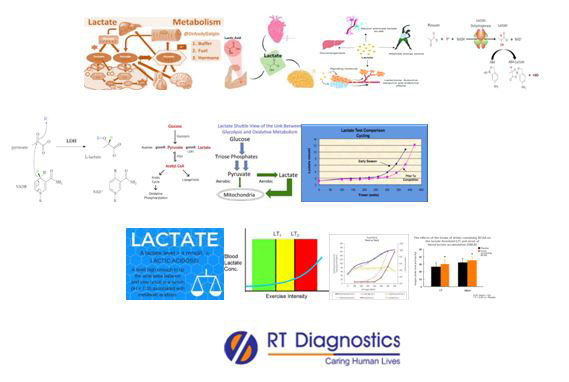Lactate:
Why Lactate Test ?
CLINICAL INFORMATION
Lactic acid is an organic acid. The conjugate base of lactic acid is called lactate. Lactic acid is commonly found in fermented dairy products, yoghurt, buttermilk etc. Lactic acid is produced by the muscles and RBCs. The levels of lactic acid get elevated when oxygen levels are reduced (eg. Hypoxia). The major source of energy for our muscle cells is through aerobic (with the presence of oxygen) respiration i.e glycolysis – break down of sugar like glucose to pyruvic acid, which then enters the TCA cycle for more energy production (ATP). But in cases such as strenuous exercises (power exercises like sprinting) muscles require instant energy and hence sugar i.e glucose is broken down anaerobically i.e the pyruvic acid (anaerobic respiration – with the absence of oxygen) instead of entering the TCA cycle, gets converted to lactic acid for the production of instant energy. The lactate dehydrogenase (LDH) enzyme catalyzes the conversion of pyruvate to lactate. Lactic acid is a metabolic end-product that gets accumulated. Hence levels of lactic acid is increased in the blood. When normal physiology is restored after strenuous exercise (power exercises like sprinting) in due course of time, while in sleep or during rest, the accumulated lactic acid is again converted into pyruvate by the heart and liver cells. Lactic acidosis is a major consequence of inadequately treated (uncontrolled) diabetes mellitus. Lactic acidosis (abnormal blood pH: acid-base imbalance) can occur in acute illness when tissues are deprived of blood eg. Heart attack (thus LDL levels are markers for myocardial infarction), sepsis etc, hence at such circumstances they undergo anaerobic respiration producing lactic acid. A lactate test is most often used to diagnose lactic acidosis, severe infection like sepsis (life-threatening systemic bacterial infection) and or meningitis (CSF sample specimen is tested for lactate levels), heart failure, shock (it is a medical emergency where the blood flow is reduced to organs and/or tissues) etc. Some of the indications for the lactic acid tests are lactic acidosis (abnormal blood pH: acid-base imbalance), sepsis (life-threatening systemic bacterial infection), meningitis etc, and their clinical manifestations are as follows. Symptoms of lactic acidosis (abnormal blood pH: acid-base imbalance) include sweet-smelling breath, nausea and vomiting, muscle weakness, sweating, shortness of breath, abdominal pain, confusion, cold and clammy skin, coma etc. Symptoms of sepsis include fever, chills, rapid heart rate, rapid breathing, confusion etc. Symptoms of meningitis include severe headache, fever, stiff neck, sensitivity to light etc. Some other indications of the lactic acid test include severe congestive heart failure, kidney failure, low red blood cell count (severe anaemia), severe lung disease or respiratory failure, an overdose of medication like metformin, beta-adrenergic agonists (albuterol, salmeterol), HIV medications etc. Other additional tests include ABG, Oxygen saturation, CBC, Tests for anaemia, LDH, Procalcitonin, imaging studies etc.

General Instructions:
Sample Requirement: Specimen - Blood sample collected from the vein/artery or CSF (as suggested by the Doctor). Test Preparation: None.
NOTE - Sample for specimen collections may vary based on the patient’s condition/cases according to the patient’s presenting complaints/signs or symptoms:
SPECIMEN REQUIREMENT (Special or Rare Cases) - As instructed and guided by Physician / Clinician / Pathologist / as per Laboratory’s requirements, according to procedures and protocols.
This Multi-Specialty Clinical Referral Laboratory RT DIAGNOSTICS provides precise and accurate tests with an extensive range of testing services to the medical centres to help in the diagnosis and identification of pathology in the test specimens for infectious diseases and also to evaluate the function of organ systems of the patient. It prevents further complications and helps to stabilize and restore health to near normalcy at the earliest without delay.



